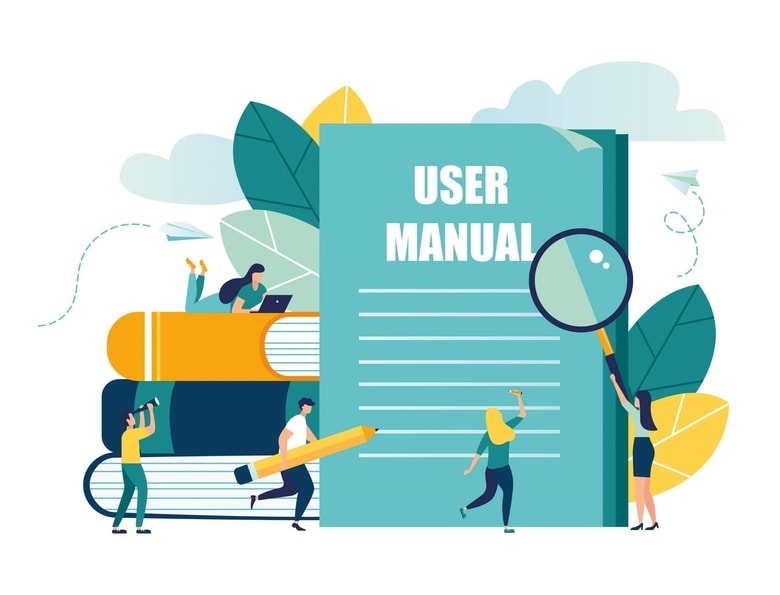
Have you ever wanted to learn how to do something, only to be frustrated by a confusing or poorly written how-to guide? It can be incredibly frustrating to spend time trying to follow instructions, only to end up more lost than when you started. But it doesn't have to be this way – with a little planning and attention to detail, a how-to guide should be able to actually help a reader achieve their goals.
How-to guides, when done right, can be incredibly useful resources for readers looking to learn a new skill or accomplish a specific task. Whether you're teaching someone how to bake the perfect cake or showing them how to fix a leaky faucet, a clear and concise how-to guide can make all the difference. But let's face it – not all how-to guides are created equal. In fact, many leave readers more confused than when they started, with vague instructions and a lack of relevant resources.
That's where this blog post comes in (hopefully)!
We'll discuss exactly what you need to know about creating a how-to guide that actually helps your readers. From defining the goal of the guide and identifying the target audience, to providing relevant resources and optimizing for search engines, we've got you covered. Whether you're a seasoned pro or a how-to guide novice, this post has something for everyone. So grab a pen and some paper (or just bookmark this page), and let's get started on creating the perfect how-to guide that will have your readers thanking you for your clarity and expertise.
What is a How-to Guide?
A how-to guide provides step-by-step instructions that walk the reader through a specific process, from start to finish. Think of it as giving someone directions on how to complete an action or achieve a goal.
You break down the process step-by-step, and you provide plenty of clear examples that make it easy for your reader to understand exactly what they should do at each step of the way. They are often used to help readers learn new skills or solve problems, and can be an effective way for the author of the guide to share their knowledge and expertise.
How-to guides can be written in a variety of formats, including text-based articles, videos, or infographics, and can cover a wide range of topics, from cooking and home improvement to personal finance and career development.
Some common examples include:
Tutorials: How-to guides can be used to teach people how to do something, such as how to use a software program or how to cook a particular dish.
DIY instructions: How-to guides can provide step-by-step instructions for completing a DIY project, such as building a piece of furniture or repairing a household appliance.
Product instructions: Many products come with how-to guides that provide instructions for setting up and using the product.
Health and wellness instructions: How-to guides can be used to provide instructions for taking care of one's health, such as how to properly brush and floss teeth or how to perform first aid.
Educational resources: How-to guides can be used as educational resources to teach people about a particular topic or concept.
Why Should You Write a How-to Guide?
Think of the main reason people use the internet: to find answers to their problems as well as additional information in order to successfully complete a task or achieve a particular goal. And if you can provide exactly the information your reader is looking for in a clear, concise format, you have yourself a winning content format.
How-to guides are necessary for every business that wants to expand its reach and grow its customer base. They're a powerful way to showcase your expertise, show the value of your products or services, connect with potential customers, and build brand trust.
From how to cook a perfect steak to how to implement the latest marketing strategy, there's a huge demand for how-to guides in nearly every industry. These guides allow you to establish yourself as a thought leader in your field and position yourself as an expert that potential customers can trust.
And when your guides impress your readers, they might just share them with their networks, advocate for your brand, and become a loyal customer.
6 Steps to Writing a How-to Guide That Converts
The following steps will help you create a how-to guide that is clear, concise, and effective in helping your reader achieve their goals.
1. Identify the Goal of Your Guide
How-to guides are the go-to format to teach people how to do something. You first need to identify the specific goal or challenge you want to address in your guide. This might be a marketing funnel issue, a product development strategy, or an HR initiative. Find out what problems trouble your customers, and think about how you can help solve them with your guide.
For example, you run a B2B SaaS company that sells marketing automation tools. You might create a guide on how to optimize your marketing funnel through data-driven decisions or how to integrate A/B testing and lead nurturing into your workflow. These topics would be relevant to your customers' issues and help position you as an expert in your field.
Reddit and Quora are great places to start your research. Look for discussions where readers ask questions or struggle with a specific problem. AnswerThePublic and Google's "People Also Ask" can also help you identify topics and keywords relevant to your guide.
Nothing beats primary research, though. Sift through customer calls, interviews, and surveys to find exactly what your target audience needs help with and their biggest pain points.
2. Identify Your Target Audience
Now that you’ve identified the goal you want to address with your how-to guide, the next step is to determine who you plan on writing the guide for as different people have different levels of knowledge and experience, and what may be obvious to one person may not be obvious to another.
Taking the time to determine who your how-to readers will be will allow you to tailor the language and level of detail in your guide to their needs and make it more effective. For example, if you’re writing a how-to guide for beginners, provide more background information and visuals and explain concepts in greater detail than you would if you were writing for more experienced readers. Or if you’re writing for technical readers, you may include industry-specific jargon that you would otherwise avoid for those that are less technical.
3. Research Similar Guides to Learn What Works (and What Doesn't)
Figure out what similar guides are already out there, understand what topics they cover, and pinpoint their strengths and weaknesses. This is an important step to learn how to create a winning content format that resonates with your audience and stands out from the competition.
For example, a search for “how to create a marketing campaign” gives results from various sources, including HubSpot and Digital Marketing Institute - both reputable sources.
Take the time to read and analyze different guides, looking for common success and failure points. What type of content is included? How are the instructions structured? What examples do they use? Do they have clear calls to action or compelling visuals? Have they used screenshots to illustrate the steps in a guide?
Know what high-ranking competitors are doing to make their guides successful, and try to incorporate these elements into your guide. But don't copy their work; improve or add unique elements that help set your guide apart.
4. Structure Your Guide in Logical Steps
Plan the guide in a sequential and organized way so readers can follow along. Ensure they learn what you're teaching without getting confused or lost.
Lay out the topics you want to cover and group them into sections so readers can quickly skim through the guide and find specific information when needed. A logical flow is also key, and you can use the "inverted pyramid" style to structure the guide.
Start with an introduction that explains the guide's purpose and what it will cover. Then, break down the main points into a number—the more precise, the better. Consider examples from other brands and customers to illustrate a point, show you're aware of what's working in the industry, and help readers understand how to apply the content in their workflows. Use action verbs and present tense in your writing to make your guide clear, concise, and easy to follow.
5. Format the Guide for Quick and Easy Reading
Proper formatting for your how-to guide should make it easy to read, easy to follow, and useful for the intended audience.
Some simple best practices to follow include:
- Use a clear, easy-to-read font and sufficient white space to make the guide easy on the eyes.
- For how-to guides that are particularly long, include a table of contents so readers can quickly see what the guide covers and navigate to the specific sections they are interested in.
- Organize the steps in a logical order, with each step represented by a numbered or bulleted list.
- Use subheadings to break up the guide into sections, making it easier for readers to find the information they need.
- Provide clear, detailed instructions for each step, using simple, straightforward language.
- Include any necessary background information, definitions, or explanations to help readers understand the topic.
- Use images, diagrams, or videos to help illustrate the steps, making it easier for readers to follow along.
- Provide a summary or conclusion at the end of the guide, outlining the key takeaways or summarizing the steps.
6. Test Your Guide and Make Any Necessary Updates
Test the guide with a sample group to ensure its flow makes sense, and the explanations are clear. Get feedback from experts or people with experience in the subject and potential customers to see if they would find it helpful.
Then, make any necessary updates before publishing the guide. Consider reading it out loud to find any errors in the text or instructions, and edit as needed.
Test how easy the guide is to navigate and whether it’s logical. Do the visuals help explain the content? Get feedback from others to ensure the guide is complete and informative.
Examples of Compelling How-to Guides
Overall, how-to guides are useful for any situation where someone needs to learn how to do something. They provide a structured, step-by-step approach that can make it easier for people to understand and follow instructions.
Hootsuite: How to Build a Better B2B Social Media Marketing Strategy
Hootsuite's how-to guide, "How to Build a Better B2B Marketing Strategy", is an excellent example of a guide that provides contextual value to readers.
The article includes stats that help readers inform their decision-making, recommends tools for future use, and provides examples of B2B brands with great social media marketing presence. This supplementary information with plenty of visuals, like graphs, charts, and videos makes the guide more engaging and an authority resource in the B2B social media marketing niche.
Takeaway: Provide additional information that makes your guide the go-to resource for the topic. Recommend other helpful resources and tools, include examples and quotes from experts in the field, or provide graphs and charts to make relevant stats easy to understand.
Buffer: How to Create Facebook Ads: A Beginners Guide
Buffer breaks down the complicated process of setting up Facebook Ads into simple steps with plenty of visuals.
The guide includes screenshots of the steps to create an ad and descriptions and tips to help readers understand Facebook's complex advertising platform. It also includes a section on how much advertising on Facebook may cost to help readers plan their budget.
Takeaway: Break down complicated processes into easy-to-follow steps with screenshots and descriptive text. Answer questions readers may have, such as the costs or benefits of the process.
Campaign Monitor: How To Get Started With Email Marketing
Campaign Monitor provides a comprehensive resource on email marketing that includes examples, screenshots, and descriptions to help readers understand. The cheat sheet at the end of the guide is especially helpful as it condenses all key takeaways into a single page for quick reference.
Takeaway: Create a resource that covers everything readers need to know about an issue or topic, from the basics to advanced tips and tricks. Summarize key takeaways for readers that skim the content, and make it easy for them to reference in the future.
Create an actionable how-to guide to help your audience
As you can see, how-to guides are a great way to provide value to your readers and help them learn how to do something new.
Every compelling how-to guide leaves no stone unturned and covers everything your readers need to know, from the basics to advanced tips and tricks. Remember to break down complex processes into easy-to-follow steps with plenty of supplementary information, such as examples, screenshots, and descriptions. You'll soon become the go-to resource for your topic or issue and help your readers achieve their goals.
Using a Knowledge Base for Your How-To Guides
While how-to guides can be published on any part of your website, such as a blog post or a landing page, depending on what your how-to guide is about, it might make more sense to use a knowledge base.
A knowledge base can particularly be a better place for customers to find a product or service how-to guides as well as for employees to find instructional content because it provides a more structured and organized environment for this type of information.
 TCL using Helpjuice's knowledge base to publish how-to guides for customers that might be looking for additional information on using a TCL product
TCL using Helpjuice's knowledge base to publish how-to guides for customers that might be looking for additional information on using a TCL product
How-to guides and other instructional content can sometimes be lengthy and detailed, and they require a clear and logical structure in order to be effective. A knowledge base is well-suited to this type of content because it allows organizations to organize their information in a way that makes it easy to find and use.
Specifically, knowledge base software typically comes with features such as categories, tags, and labels, as well as the ability to create custom taxonomies and hierarchies to make content more organized.
Additionally, knowledge base software typically comes with advanced search features that not only allow a user to search within specific categories or tags, but they also support natural language queries.
![How to Write an Instruction Manual [With Examples]](https://static.helpjuice.com/helpjuice_production/uploads/upload/image/4752/direct/1660964116996-Instruction%20Manual.jpg)

![How to Write an Effective FAQs Page [With Examples]](https://static.helpjuice.com/helpjuice_production/uploads/upload/image/4752/direct/1709664714926-1709664714926.png)
![Guide to Training Call Center Agents [2024]](https://static.helpjuice.com/helpjuice_production/uploads/upload/image/12982/3585033/1698261103181-call-center-agent-turnover-previous-5-years-infographic.jpg)

